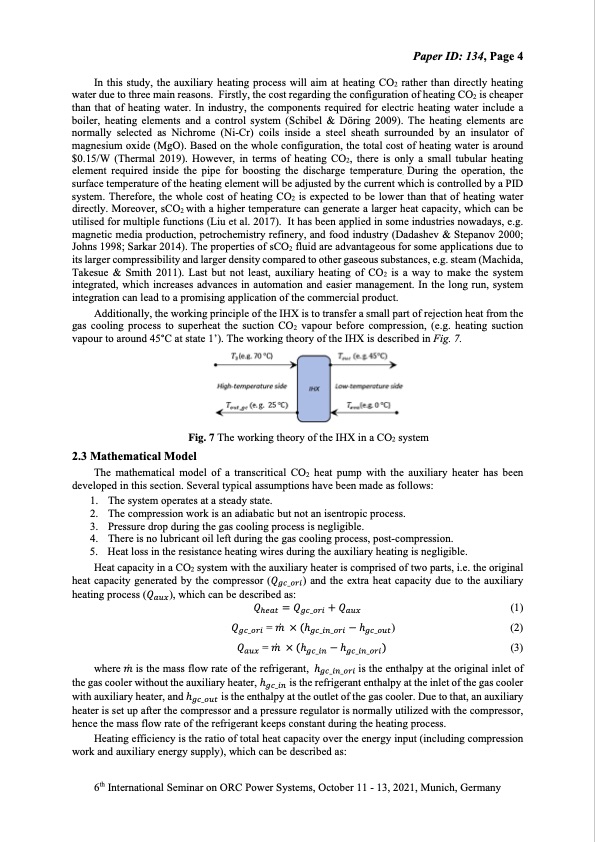
PDF Publication Title:
Text from PDF Page: 004
Paper ID: 134, Page 4 In this study, the auxiliary heating process will aim at heating CO2 rather than directly heating water due to three main reasons. Firstly, the cost regarding the configuration of heating CO2 is cheaper than that of heating water. In industry, the components required for electric heating water include a boiler, heating elements and a control system (Schibel & Döring 2009). The heating elements are normally selected as Nichrome (Ni-Cr) coils inside a steel sheath surrounded by an insulator of magnesium oxide (MgO). Based on the whole configuration, the total cost of heating water is around $0.15/W (Thermal 2019). However, in terms of heating CO2, there is only a small tubular heating element required inside the pipe for boosting the discharge temperature. During the operation, the surface temperature of the heating element will be adjusted by the current which is controlled by a PID system. Therefore, the whole cost of heating CO2 is expected to be lower than that of heating water directly. Moreover, sCO2 with a higher temperature can generate a larger heat capacity, which can be utilised for multiple functions (Liu et al. 2017). It has been applied in some industries nowadays, e.g. magnetic media production, petrochemistry refinery, and food industry (Dadashev & Stepanov 2000; Johns 1998; Sarkar 2014). The properties of sCO2 fluid are advantageous for some applications due to its larger compressibility and larger density compared to other gaseous substances, e.g. steam (Machida, Takesue & Smith 2011). Last but not least, auxiliary heating of CO2 is a way to make the system integrated, which increases advances in automation and easier management. In the long run, system integration can lead to a promising application of the commercial product. Additionally, the working principle of the IHX is to transfer a small part of rejection heat from the gas cooling process to superheat the suction CO2 vapour before compression, (e.g. heating suction vapour to around 45°C at state 1’). The working theory of the IHX is described in Fig. 7. Fig. 7 The working theory of the IHX in a CO2 system 2.3 Mathematical Model The mathematical model of a transcritical CO2 heat pump with the auxiliary heater has been developed in this section. Several typical assumptions have been made as follows: 1. The system operates at a steady state. 2. The compression work is an adiabatic but not an isentropic process. 3. Pressure drop during the gas cooling process is negligible. 4. There is no lubricant oil left during the gas cooling process, post-compression. 5. Heat loss in the resistance heating wires during the auxiliary heating is negligible. Heat capacity in a CO2 system with the auxiliary heater is comprised of two parts, i.e. the original heat capacity generated by the compressor (𝑄_) and the extra heat capacity due to the auxiliary heating process (𝑄), which can be described as: 𝑄 𝑄_ 𝑄 (1) 𝑄_ = 𝑚 h__ h_) (2) 𝑄 = 𝑚 h_ h__ (3) where 𝑚 is the mass flow rate of the refrigerant, h__ is the enthalpy at the original inlet of the gas cooler without the auxiliary heater, h_ is the refrigerant enthalpy at the inlet of the gas cooler with auxiliary heater, and h_ is the enthalpy at the outlet of the gas cooler. Due to that, an auxiliary heater is set up after the compressor and a pressure regulator is normally utilized with the compressor, hence the mass flow rate of the refrigerant keeps constant during the heating process. Heating efficiency is the ratio of total heat capacity over the energy input (including compression work and auxiliary energy supply), which can be described as: 6th International Seminar on ORC Power Systems, October 11 - 13, 2021, Munich, GermanyPDF Image | NOVEL TRANSCRITICAL CO2 HIGH- TEMPERATURE HEAT PUMP

PDF Search Title:
NOVEL TRANSCRITICAL CO2 HIGH- TEMPERATURE HEAT PUMPOriginal File Name Searched:
1633140.pdfDIY PDF Search: Google It | Yahoo | Bing
CO2 Organic Rankine Cycle Experimenter Platform The supercritical CO2 phase change system is both a heat pump and organic rankine cycle which can be used for those purposes and as a supercritical extractor for advanced subcritical and supercritical extraction technology. Uses include producing nanoparticles, precious metal CO2 extraction, lithium battery recycling, and other applications... More Info
Heat Pumps CO2 ORC Heat Pump System Platform More Info
| CONTACT TEL: 608-238-6001 Email: greg@infinityturbine.com | RSS | AMP |